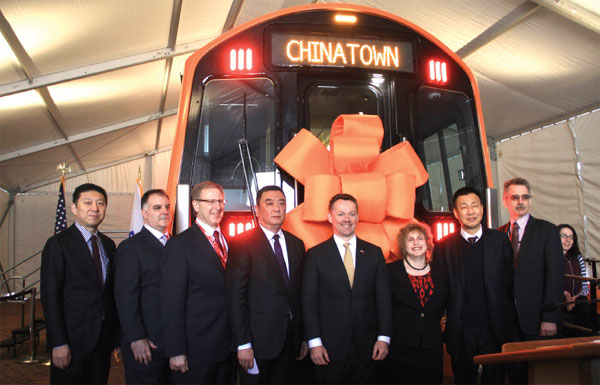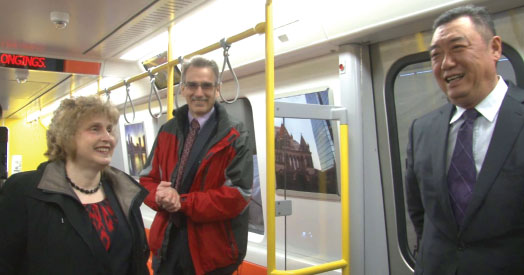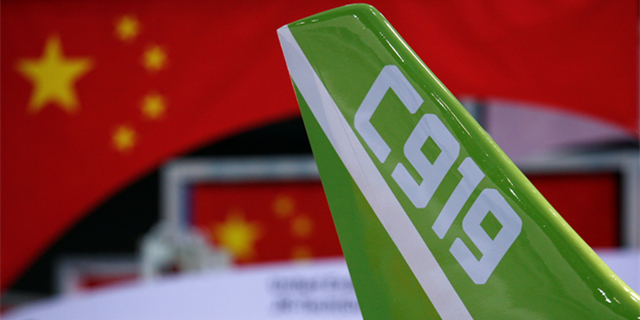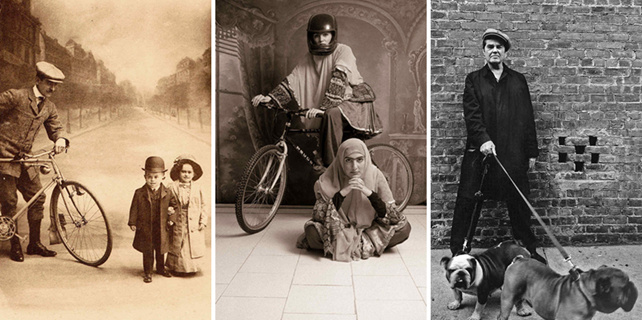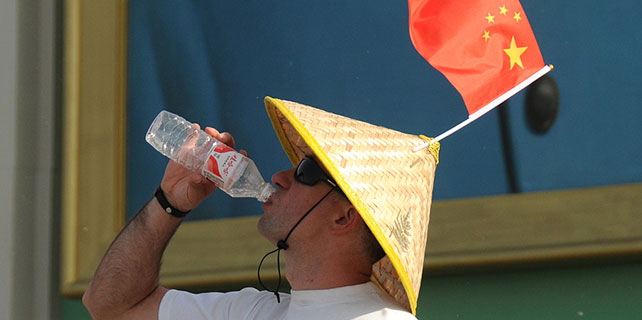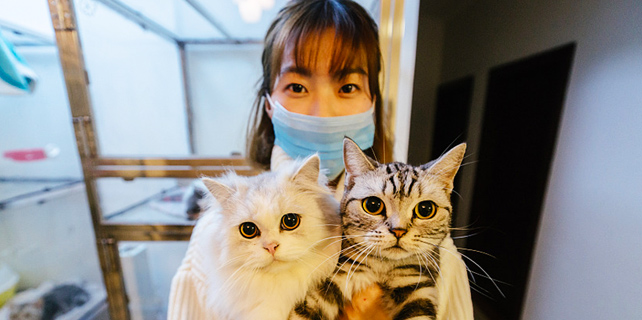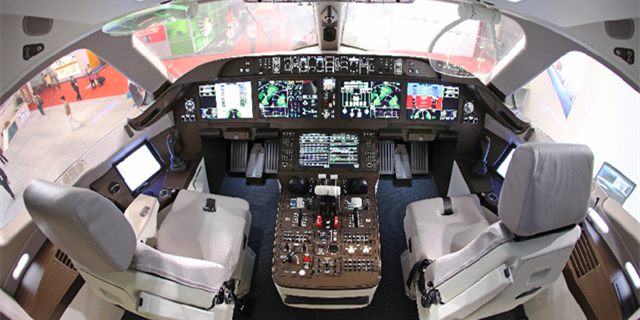CRRC: On a roll in the US
For Tammi Vancini, China Railroad Rolling Stock Corporation's building of a railcar manufacturing plant in Springfield, Massachusetts, means her first trip to China, and the return of manufacturing to her city, Hong Xiao reports from Springfield.
Tammie Vancini, 52, was a little anxious about her upcoming first trip to China.
But talking about her impression of China, the Springfield, Massachusetts, resident couldn't hide the excitement in her voice. "China has a lot of people, intelligent people, innovation, and, of course, food," she said.
On April 7, Vancini started to meet those people and eat that food. She was among 33 newly hired employees of China Railroad Rolling Stock Corporation (CRRC) MA Corp in Springfield to arrive at CRRC's manufacturing plant in Changchun, the capital city of Jilin province in North China.
Vancini, an electrical assembler at CRRC's plant in Springfield, and her colleagues went to China for a three-month training program to learn railcar manufacturing technology at the world's largest manufacturer of railroad rolling stock.
Springfield - a city of about 154,000 people in western Massachusetts that is home to the Naismith Memorial Basketball Hall of Fame - is becoming a manufacturing hub for CRRC to assemble rail cars in the US. CRRC is building a 204,000-square-foot, $95 million plant, part of its $566.6 million contract with Boston's transit authority signed in October 2014.
CRRC will manufacture 152 railcars for the Orange Line and 132 cars for the Red Line to replace the cars now in service, which were built by Hawker Siddeley Canada between 1979 and 1981.
Since signing its initial contract with CRRC, Boston's transit agency added a $277 million contract for an additional 120 Red Line cars, a deal that includes the option to purchase 14 more cars.
Production is scheduled to get underway in April 2018, with the cars entering service between 2019 and 2023. The plant is expected to create jobs for 150 people.
|
Jia Bo (left), vice-president of CRRC MA; Zhou Chuanhe (fourth from left), president of CRRC MA; Brian Shortsleeve (fourth from right), chief administrator and acting general manager of MBTA; Stephanie Pollack (third from right), secretary and CEO of the Massachusetts Department Of Transportation; An Zhongyi (second from right), president of CRRC Changchun; and other guests stand in front of the mock-up of Boston's new Orange Line subway car built by CRRC, which was unveiled to the public at Boston's City Hall Plaza on April 13. Hong Xiao / China Daily |
The first subway in the United States started operating in Boston on Sept 1, 1897, and Stephanie Pollack, secretary and CEO of the Massachusetts Transportation Department, said, "We are confident that CRRC will be able to deliver the vehicles that we need to move the MBTA (Massachusetts Bay Transportation Authority) into the 21st century."
The Boston contract - China's first major rail contract in North America - was won before the June 2014 merger of CNR Corporation and CSR Corporation, forming CRRC Corp Ltd, a state-owned enterprise that became the largest train maker in the world. CRRC has projects in more than 100 countries and regions. It has 170,000 employees.
"The MBTA is the oldest subway system in America," said Brian Shortsleeve, chief administrator of the MBTA. "When we decided to upgrade and modernize our subway system eight years ago, we picked CRRC and they are doing a great job. We are really excited to modernize the subway system with these vehicles."
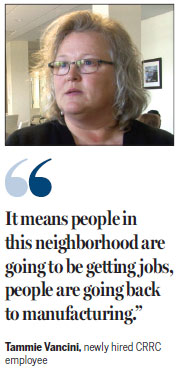
"Boston has many firsts," said An Zhongyi, general manager of CRRC Changchun. "In particular, the MBTA established the first subway of the United States here in 1897. We understand the primary commitment to having a public transportation system available to residents and visitors."
Vancini said she joined CRRC at the beginning of this year because "I wanted to broaden my horizon. I wanted to be part of an innovative company expanding here in the United States."
And expanding is what CRRC is doing.
Since being awarded the Boston contract, it has won contracts in Philadelphia, Chicago and Los Angeles, and the company is eyeing other major US cities, such as New York.
Jia Bo, vice-president of CRRC, said it is CRRC's "comprehensive strength" that makes it stand out from other international competitors in bidding for deals. "The transit agencies see the maximum value from our projects," he told China Daily in an interview at his office in Boston.
Jia also pointed to CRRC accumulating a great amount of experience and improving its technology through its development of China's rail infrastructure as giving the company an edge over competitors.
"The American rail transit system is facing upgrading, and after taking office, US President Trump has emphasized strengthening infrastructure construction, that includes the construction of rail infrastructure," Jia said.
Jia believes there is plenty of room for China-US cooperation in the rail transit field and CRRC's winning of deals in the US indicates the openness of trade and investment between the two countries is overwhelming.
Here is a breakdown of the US deals signed by CRRC:
Chicago - On March 24, CRRC Sifang America, a unit of CRRC, broke ground for a $100 million plant that will build railcars for the city's transit authority and become the company's North American hub for the assembly of railcars. In 2016, CRRC Sifang was awarded a $1.3 billion contract by the Chicago Transit Authority (CTA) to supply more than 840 new railcars to replace approximately half of the agency's fleet. The plant will employ around 170 people and create nearly 200 construction jobs. Production will begin in early 2019. After testing, the cars are expected to be delivered by 2020.
Philadelphia - The Southeastern Pennsylvania Transit Authority (SEPTA) approved the purchase of 45 multilevel coaches on March 23 for $137 million. The deal includes an option for 10 more cars, which, if exercised, would result in the contract's value rising to $161 million. The coaches will be produced primarily at CRRC's plant in Springfield. The first of the coaches are expected to be delivered in late 2019. They will be paired with the transit authority's new electric locomotives, which are being built by Siemens of Germany.
Los Angeles - A $647 million contract for 282 railcars was announced on March 27 and signed on April 19 by the Los Angeles County Metropolitan Transportation Authority (LA Metro). The contract will create about 50 jobs, generating up to $38 million in local wages and benefits. About 10 percent of the new jobs will be for disadvantaged workers and workers from lower social economic communities. CRRC will invest in a Los Angeles-based plant to manufacture major components, while the final assembly will be done at the Springfield plant.
CRRC won those contracts by bidding lower than competitors Canada's Bombardier, Germany's Siemens, France's Alstom, and Japan's Hitachi and Kawasaki Heavy Industries.
Its $567 million proposal for Boston was 50 percent cheaper than Bombardier's bid. In Philadelphia, CRRC bid $137.5 million, easily beating Bombardier, which bid $171.5 million, and the $187.8 million bid by Hyundai Rotem of South Korea.
|
Stephanie Pollack (left), secretary and CEO of the Massachusetts Department of Transportation, and Zhou Chuanhe (right), president of CRRC MA, take a tour of the mock-up of the Massachusetts Bay Transportation Authority's new orange line train on Monday at City Hall Plaza in Boston. Zhou Pai / China Daily |
In Los Angeles, LA Metro said CRRC "had the highest-rated technical offer and lowest price, while offering the most robust local employment program and highest US component content", adding that CRRC is meeting Washington's "Buy America" provisions, which require 60 percent of components to be made in the US.
For Springfield, the new CRRC plant means "it's back to the future", said Springfield Mayor Domenic J. Sarno on April 7 at a sendoff at Bradley International Airport for Vancini and her colleagues.
The CRRC plant re-establishes manufacturing in a city that was known for its precision manufacturing and as a beehive of diversified production during the 19th and early 20th centuries.
It also was once a national center for railcar manufacturing, the home of Wason Manufacturing Co, which was one of the largest makers of railroad cars and locomotives in the US from 1845 until the Great Depression. But the area experienced an economic decline throughout the latter half of the 20th century, which was accelerated by the decommission of the Springfield Armory in 1969.
"Economically, I think it would have a large impact on this area, not just Springfield but Boston itself. The better what we do, the better the company does, and at this point it means more industries coming back, the more cars we can build. It means people in this neighborhood are going to be getting jobs, people are going back to manufacturing," said Vancini, who was a telecommunication installation technician before joining CRRC.
None of the 33 workers had been to China, so an orientation program was held in a renovated building at the site where CRRC's plant is under construction.
Students from the Pioneer Valley Chinese Immersion Charter School in Hadley, Massachusetts, taught Vancini and her colleagues simple conversational Chinese: "Ni Hao. Qing Wen Zhe Ge Duo Shao Qian" - "Hello" and "Could you tell me how much this is?"
As for Vancini, the only woman among the 33 workers, she said her family, including a grandson, are going to "miss me, but they are behind me 100 percent".
Contact the writer at xiaohong@chinadailyusa.com
(China Daily USA 05/05/2017 page20)



